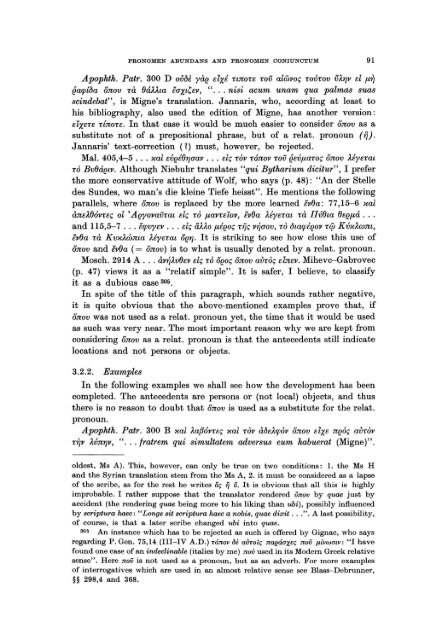Pronomen Abundans and Pronomen Coniunctum. A ... - DWC
Pronomen Abundans and Pronomen Coniunctum. A ... - DWC
Pronomen Abundans and Pronomen Coniunctum. A ... - DWC
Create successful ePaper yourself
Turn your PDF publications into a flip-book with our unique Google optimized e-Paper software.
PRONOMEN ABUNDANS AND PRONOMEN CONIUNCTUM 91<br />
Apophth. Patr. 300 D ovtJè yàe elXé nnou 'OV alwvoç .ov.ov VATjV el f-l~<br />
éaep{tJa önov .à OáAAW saXlCl3v, " ... nisi acum unam qua palmas suas<br />
scindebat", is Migne's translation. Jannaris, who, according at least to<br />
his bibliography, also used the edit ion of Migne, has another version :<br />
eiX13U .{nou. In that case it would be much easier to consider önov as a<br />
substitute not of a prepositional phrase, but of arelat. pronoun (ij).<br />
Jannaris' text-correction (1) must, however, be rejected.<br />
Mal. 405,4-5 ... "at 13veéOTjaav ... elç .ov .6nov 'OV éevf-la.oç önov Uye.al<br />
.0 BvOáetv. Although Niebuhr translates "qui Bytharium dicitur", I prefer<br />
the more conservative attitude of Wolf, who says (p. 48): "An der Stelle<br />
des Sundes, wo man's die kleine Tiefe heisst". He mentions the following<br />
paralleis, where önov is replaced by the more learned svOa: 77,15-6 "at<br />
Wtû06vuç Ot ' AeyovaVial elç .0 f-lav.ûov, svOa Uynal .à IIvOla 013ef-lá . ..<br />
<strong>and</strong> 115,5-7 ... sepvyev ... elç aA;'o f-léeoç -rijç v~aov, .0 l5taepéeov'0 Kv,,;'wm,<br />
svOa .à K V"Awma Uyl3ial 0eTj. It is striking to see how close this use of<br />
önov <strong>and</strong> lvOa (= önov) is to wh at is usually denoted by arelat. pronoun.<br />
Moseh. 2914 A .. . àV~AVOI3V elç.o oeoç önov av.oç I3lnI3V. Mihevc-Gabrovec<br />
(p. 47) views it as a "relatif simpie". It is safer, I believe, to classify<br />
it as a dubio us case 305.<br />
In spite of the title of this paragraph, which sounds rather negative,<br />
it is quite obvious that the above-mentioned examples prove that, if<br />
önov was not used as arelat. pronoun yet, the time that it wouid be used<br />
as such was very near. The most important reason why we are kept from<br />
considering önov as arelat. pronoun is that the antecedents still indicate<br />
locations <strong>and</strong> not persons or objects.<br />
3.2.2. Examples<br />
In the following examples we shall see how the development has been<br />
completed. The antecedents are persons or (not local) objects, <strong>and</strong> thus<br />
there is no reason to doubt that önov is used as a substitute for the relat.<br />
pronoun.<br />
Apophth. Patr. 300 B "at Aaf36vuç "at .ov àtJûepov önov elXe neoç av.ov<br />
.~v ;'vnTjv, " .. . jratrem qui simultatem adversU8 eum habuerat (Migne)".<br />
oldest, Ms A). This, however, can only be true on two conditions: 1. the Ms H<br />
<strong>and</strong> the Syrian translation stem from the Ms A, 2. it must be considered as a lapse<br />
of the scribe, as for the rest he writes oç ~ ö. It is obvious that all this is highly<br />
improbable. I rather suppose that the translator rendered önov by quae just by<br />
accident (the rendering quae being more to his liking than ubi), possibly influenced<br />
by scriptura haec: "Longe sit scriptura haec a nobis, quae dixit . ..". A last possibility,<br />
of course, is that a later scribe changed ubi into quae.<br />
305 An instance which has to be rejected as such is offered by Gignac, who says<br />
regarding P. Gen. 75,14 (lIl-IV A.D.) Tónov bi aVToîç naeáaX€ç nov p.ivwGtv : "I have<br />
found one case of an indeclinable (italics by me) nov used in its Modern Greek relative<br />
sense" . Here nov is not used as a pronoun, but as an adverb. For more examples<br />
of interrogatives which are used in an almost relative sense see Blass- Debrunner,<br />
§§ 298,4 <strong>and</strong> 368.
















